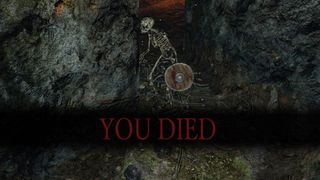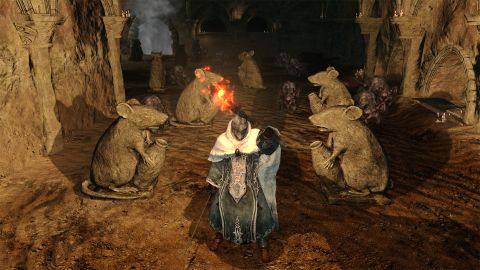Our Verdict
More accessible, challenging, and rewarding than its predecessor, this is the Dark Souls sequel PC gamers deserve.
PC Gamer's got your back
I am not going to die before I get my corpse. I can make it, despite the hordes of hollows lying in the shadows, just waiting to hoist themselves up to my eye level to snack on my face. I used my last estus flask after a fleshy dog-thing lunged at me from the shadows, mistaking my bone staff for its chew toy. But that's okay: I can still get to the edge where I fell, while trying to cross a chasm by leaping through the air. I missed.
Suddenly I see it, a splash of green highlighting the barely visible horizon. I creep forward, keeping my shield raised in case a feral hollow charges me. That shield doesn't help much when one attacks me from behind, though, so I quickly try to roll away. And that's how I toss myself right off the edge of the world, losing 25,000 souls in the process. "You Died," says Dark Souls 2. Again.

There were rumors and concerns in the early days, when we knew nothing about what developer From Software had planned for us, that the sequel to the legendarily difficult Dark Souls would be made easier. In hopes of attracting a larger audience, the people who had heard the faithful proclaim its greatness, the next version of the Souls series would be more accessible, less obtuse, and far less punishing.
Those rumors were misleading. Rest assured: This is not Dark Souls for babies. And even if you've mastered the complex combat mechanics and subtle intricacies of the first game, that knowledge will not be enough to make up for everything that's new, expanded, and different in the sequel. Dark Souls 2 teaches you, very early on, that you still have a lot to learn.
Walking dead
Dark Souls 2 curses you right from the beginning. Your character begins as a faceless amnesiac who is drawn to the kingdom of Drangleic, where memories are forgotten and heroes become hollows—undead who require souls to keep their humanity. Your only chance to fight the curse is to collect four great, old souls and confront the king of this cursed land. You'll need to collect lots of lesser souls to level up you skills, purchase items and services, and trade with those you meet. If you die (sorry, when you die) you lose the souls you've collected and must find the spot you died in to retrieve them. Fail before you hit that spot and they're gone forever. That will happen a lot, too.
Like the first game, exploring a new area requires patience and risk in equal measure. I love the dread I experience when I approach a fog gate, a sort of progress marker that often means harder challenges lie ahead, including bosses. I question whether I'm ready to move forward. Sometimes I am—often, I am not. It's at moments like this when I feel that Dark Souls 2 is trolling me. I encounter one fog gate in Earthen Peak, a factory for poisonous sludge, and steel myself for a brutal duel with the boss I'd been expecting. I change weapons, add buffs to do more magic damage, consume life gems to heal full health, and return myself to full humanity by using a Human Effigy. But though the open gate, there's only a bonfire—the game's safe haven. All of my prep was for nothing.
In another area, I throw open a door that opens into a wall. I feel like the developer knows exactly what's going through my head and does its best to confound me. That keeps my exploration consistently interesting—just as I think I know what's next, Dark Souls 2 takes a sharp left turn.

The bonfires also serve a dual purpose—they're the fast travel points that connect Dark Souls 2's areas. They're linked at Majula, a hub village where you encounter merchants, blacksmiths, and the Emerald Lady. She's the only way you can level, spending souls to improve stats that are more clearly expressed than they were in Dark Souls. That means you'll be returning to Majula more than you did Firelink Shrine. Don't imaging a bustling hive of activity. The residents of Majula are lonely, depressed, filled with dread and absent of hope—like a summer camp for emo LARPers. Each has a story to tell, if you're patient enough to listen, and all are voice acted with impeccable detail. Their stories are how you discover the history of Drangleic, and watching their plight unfold through conversation draws me in far more than audio logs or cutscenes. I want to unravel their mysteries, and I have to pay careful attention to find the clues in each character's dialogue—especially if I want their help.
The hub structure is one of a few changes that either streamline existing systems, or provide new challenges to veteran players. Multiplayer in Dark Souls 2 now uses Steamworks and dedicated servers instead of the dreaded Games for Windows Live of its predecessor. Many of the game's covenants—guilds that task you with multiplayer duties, such as defending areas or invading misbehaving players' worlds—are more socially focused. You can still summon random players into your world to help with difficult areas or bosses while in human form. You can even purchase a special ring and engrave it with the same god's name as your friends, increasing your chances of joining them for jolly cooperation. You're given more options when dealing with PvP invaders, as well, though you are way more vulnerable to invasions since they can happen while you're in hollow form.

Even while fast traveling through bonfires, though, Drangleic never feels much like an open world. Instead, the game pushes you in specific directions, especially in the early game. The Forest of Fallen Giants will lead to a specific path, and when you eventually get to the end, the game just warps you back to Majula. The three other spokes work in much the same way, and rarely connect to each other. Part of the magic of Dark Souls was how the world eventually connects its puzzle pieces to each other, and discovering the shortcuts you could take made the game feel like one solid world.
Dark Souls 2 also struggles to commit to one of its boldest gameplay changes: the importance of darkness. Early info on the game highlighted how players would need to light torches and navigate environments steeped in darkness, as yet another way the game would fray your nerves. In practice, lighting the way is rarely as important as it should be. Torches feel optional in most of the game's areas, and the sections that reward sacrificing your shield arm to carry them, such as No-Man's Wharf and The Gutter, never quite reward that sacrifice enough to be worth the vulnerability. It's a disappointing result to what could have been a key gameplay mechanic, especially since those lighting effects look so spectacular on the PC.
Masterwork
From Software promised us that the PC port would be the definitive version of the game, and it did not disappoint. Resolutions up to 1440p are supported natively, as well as specific settings for texture quality, anti-aliasing, SSAO, anisotropic filtering, higher-detail character models, and more. Even with those settings maxed, I couldn't make the game run lower than 60 fps on a modest Nvidia GTX 750 Ti. That's a massive improvement over its predecessor.

Those who refuse to set hands on a controller will also be satisfied by a new, comprehensive keybinding system. While Dark Souls 2 is still clearly designed for a controller, it now takes only a little bit of setup to build a comfortable control scheme.
The result is a port that looks markedly better than its console cousins, even at standard 1080p on modest hardware. Textures are sharper, while character details are easier to make out. Screenshots and YouTube videos may not convey just how much better Dark Souls 2 looks with everything cranked up.
Dark Souls was a brilliant game that didn't explain itself well. Many new players were frustrated even by the tutorial because the game didn't teach its secrets to them. Dark Souls 2 fixes that by giving you way more information about its items, skills, and world, liberating its designers to create even more complex challenges. It is more accessible for new players, but not at the expense of being brutal—I've died more than 150 times in 60 hours. I curse out loud every time a hollow pushes me off an edge, at every fire arrow I can't dodge, at The Pursuer every god damned time I fight him. I die, over and over, one stupid mistake after another. But even though failing sucks, succeeding in Dark Souls 2 feels absolutely amazing. I'll die a hundred more times just to feel that good when I win.
More accessible, challenging, and rewarding than its predecessor, this is the Dark Souls sequel PC gamers deserve.

